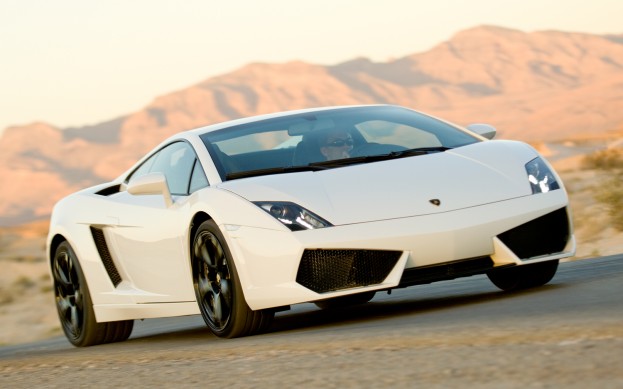– Chinese Ultra-Luxury Car Bubble Pops As 1 Year Old Used Lambo Gallardo Sells 70% Off Sticker (ZeroHedge, July 31, 2012):
Rumors are circulating that reports of the demise of the Chinese auto market may be exaggerated now that even David Einhorn is forced to defend his GM long (because it “has a strong cash position” – sure, and stuffs channels like no other) however stripped of stereotypes and hype, the reality is that even the one time impregnable ultra luxury car market in China is now faltering at an ever faster pace. BusinessWeek reports: “Waiting lists for ultra-luxury cars in Hong Kong are getting shorter and used-car lots are cutting prices on Lamborghinis, Ferraris and Bentleys in the latest sign of China’s slowdown. At first glance, the numbers are deceiving: Sales of very expensive new autos surged 47 percent in the first six months, according to industry analyst IHS Automotive. Look more deeply, however, and another picture emerges, especially in the city’s used-car lots.” The picture is ugly: ““The more expensive the car, the more dry the business,” said Tommy Siu at the Causeway Bay showroom of Vin’s Motors Co., the used-car dealership he founded two decades ago. Sales of ultra-luxury cars have halved in the past two or three months, he said. “A lot of bankers don’t want to spend too much money for a car now. At this moment, they don’t know if they’ll have a big bonus.”” Sad: they should all just go to Singapore and manipulate Libor. Oh wait, too soon?
Curiously, unlike virtually every other manipulated asset class, Hong Kong car sales provide a somewhat insulated view into the heart of China’s beating economy:
Unlike Rolex watches, Gucci handbags and other luxury goods, Hong Kong’s car market hasn’t been distorted by the more than 28 million mainland Chinese who flocked to the city last year. Mainland shoppers spend 44 billion euros ($54 billion) on luxury goods while traveling overseas to locations such as Hong Kong and Europe, according to CLSA Asia-Pacific Markets.
“In the car market, it’s not buying like watches,” said Bill Russo, a Beijing-based senior adviser at Booz & Co. “Here you are getting a true look at a category of product bought by Hong Kong buyers. It’s a pulse check on how Hong Kong residents view the stability of the financial system.”
The new-car figures look better because of some short-term developments. The release of the latest models from Ferrari and Lamborghini and the opening of the first Hong Kong showroom by McLaren — maker of the 592-horsepower MP4-12C carbon-fiber coupe — have given sales a bump. Meantime, depressed demand in Europe means a bigger allocation of new cars for Hong Kong dealers.
So what do full ultra-luxury car lots tell us about China’s humming economy? Like everything else, it is still a tale of two words: new and used. New, for now is stable…
There were 273 new Bentleys, Lamborghinis, Rolls Royces, Ferraris, Aston Martins and McLarens sold in the six months to June 30, up from 186 in the first half of last year, according to Englewood, Colorado-based IHS. This outpaced the 23 percent gain in the U.S., the world’s richest nation, and the 40 percent jump in mainland China, the world’s biggest car market, IHS data show.
For these buyers, price isn’t an issue and settling for second-hand is not an option, Russo said.
“It’s the brand image and it says something about you,” said Russo, who was formerly Chrysler Group LLC’s China head. “Used-car buyers are more price sensitive and economic cycles will affect these shoppers more. They are paying for the cars with their income as opposed to their savings.”
However, the other half of the equation, the formerly stable used car market, has now imploded. What does that mean for the average uber-wealthy American with a hankering for a new Gallardo? Go east, young man, where you can get the car at 70% of retail! Chinese retail that is.
A yellow, 2011 Lamborghini Gallardo 550 recently listed for HK$2.88 million ($371,000) on second-hand car website 28car.com is about $830,000 cheaper than a new model — chump change that would buy a new Mercedes E-Class Coupe to run the kids to school. A silver-gray 2011 Ferrari California with 980 kilometers (613 miles) on the clock is available for HK$2.68 million. That’s a 19 percent discount to a brand new 2012 vehicle, and HK$400,000 cheaper than a 2011 version sold by Ferrari’s official in-house used-car dealer.
In short the car bubble has popped:
Someone looking to sell a 2009 Bentley Continental will have to accept HK$1.7 million, a third less than they would have received at the start of the year, Chan said.
In the basement automall beside Hong Kong’s Grand Hyatt hotel, trader Samuel Chui said he has stopped buying more cars.
“People want cash now, they don’t want the commodity,” said Chui, who reduced the number of car lots he rents from 15 to nine at the end of last year as business began to slow. “We’ve got plenty of stock and it’s not moving.”
For now the marginal liquidity crunch has only impacted the used car market. Very soon the new car market will be hit too. And when that happens the Chinese luxury automarket is done, and with it sales of the highest margin products for car manufacturers everywhere, but especially in Germany and Italy. What happens then to a legacy European industry that is responsible for tens of millions of upstream and downstream jobs?

1 thought on “Chinese Ultra-Luxury Car Bubble Pops As 1 Year Old Used Lamborghini Gallardo Sells 70% Off Sticker”